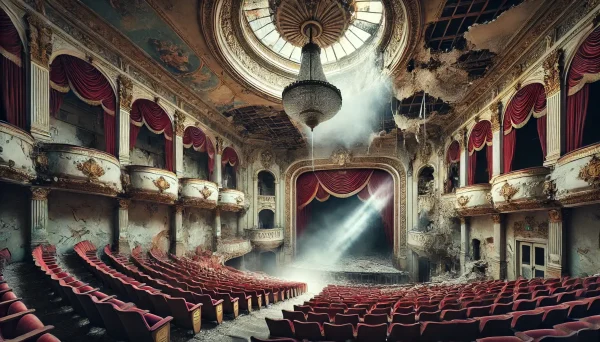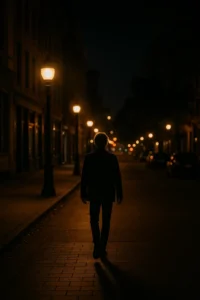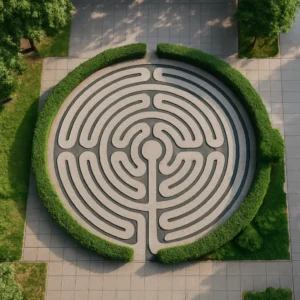Once alive with music, applause, and the collective energy of an audience, many grand theaters around the world now sit in silence—empty shells of their former glory. These abandoned theaters, often marked by decaying velvet seats, crumbling facades, and fading murals, are hauntingly beautiful monuments to the cultural heartbeat of bygone eras. Their stories tell of golden ages of performance, shifting urban landscapes, economic collapse, and the enduring mystery of forgotten spaces built for spectacle.
1. Loew’s Kings Theatre – Brooklyn, USA
Opened in 1929 as one of the original “Loew’s Wonder Theatres,” the Kings Theatre was once a glamorous movie palace featuring lavish French Renaissance-style interiors. After closing in 1977, it was left abandoned for decades. Though partially restored in the 2010s, for years it stood as a haunting relic—its chandeliers hanging in darkness, its gold-leaf accents dulled by dust. The story of its decline and rebirth reflects Brooklyn’s broader urban transformation.
2. The New Bedford Orpheum – Massachusetts, USA
Built in 1912, the Orpheum in New Bedford was a combination vaudeville house and retail space. It was part of the legendary Orpheum Circuit, hosting live performances and films. After closing in the mid-20th century, parts of the building were used for storage, but the theater remained untouched. Its decayed auditorium—with peeling paint, silent balconies, and weathered décor—is a haunting tribute to a once-vibrant entertainment scene.
3. The Teatro Sociale di Como – Italy
Though still partially in use, parts of the historic Teatro Sociale have long been closed off due to structural concerns. Built in 1813, the theater once welcomed European nobility and opera’s greatest stars. Sections of its grand interior, hidden from public view, reveal forgotten dressing rooms, dust-covered stage props, and untouched corridors—remnants of a cultural institution that helped shape the performing arts in northern Italy.
4. The Lawndale Theater – Chicago, USA
Once a majestic neighborhood movie house, the Lawndale Theater opened in 1927 but fell into decline as the city’s demographics and economics changed. Eventually shuttered and left to decay, its Art Deco features faded beneath layers of grime. Urban explorers discovered its vast interior still holding remnants of vintage film equipment, crumbling seating, and silent echoes of its past life as a communal gathering place.
5. The Rozhledna Theater – Czech Republic
Located in a small village, the Rozhledna Theater was once a proud part of the local culture. Today, it stands abandoned with cracked walls, a collapsed roof, and broken stage lights still hanging from the rafters. Local legends speak of ghostly performances and phantom footsteps—adding an eerie mystique to this decaying but photogenic site.
6. The Paramount Theatre – Newark, USA
This grand 2,300-seat theater opened in 1886 and operated for decades before closing in the 1980s. Though parts of the building have been repurposed, the theater itself remains dark and haunting. The once-ornate interior, with its intricate plasterwork and massive stage, is now filled with dust, graffiti, and crumbling splendor. The Paramount is a testament to the changing tides of urban entertainment and preservation challenges.
7. The Noga Theater – Jaffa, Israel
Originally opened in the 1930s, the Noga Theater was a major cultural site during the British Mandate period. After decades of operation, it was closed and neglected, though its striking Bauhaus-style architecture still catches the eye. The empty lobby and graffiti-covered interior reflect both the theater’s rich past and its uncertain future in a rapidly modernizing city.
8. The Metropol Theater – Buenos Aires, Argentina
Once a bustling venue for tango shows and dramatic plays, the Metropol Theater slowly faded as modern multiplexes and economic turmoil took their toll. Abandoned for years, it became a site of street art and underground performances before being partially restored. Parts of the original seating and grand balconies remain untouched, offering a glimpse into Argentina’s artistic legacy.
9. The Olympia Theatre – Dublin, Ireland
Although still active today, the Olympia Theatre once faced abandonment and deterioration in the 1970s. During this time, urban explorers documented its darkened hallways and weather-damaged balconies. The threat of demolition was real before a public outcry saved it. Its near-loss remains a powerful reminder of how cultural heritage can be forgotten in times of transition.
10. The Salone Margherita – Naples, Italy
Hidden beneath a historic shopping arcade, the Salone Margherita was once a luxurious cabaret venue, complete with velvet décor, private boxes, and a mirrored lobby. After decades of disuse, the space was rediscovered—nearly intact but deeply weathered. Murals flake off walls, chandeliers hang precariously, and the sense of faded opulence lingers in the air.
Conclusion: Echoes of Applause in Empty Halls
Abandoned theaters are more than ruins—they are time capsules of a society’s dreams, passions, and communal joys. Their stages may be dark, but their presence continues to inspire artists, historians, and explorers. These spaces, once filled with laughter, tears, and thunderous applause, now echo with silence—but also with memory. Whether restored or left to nature, they remind us of the power of performance and the fragility of cultural spaces when left behind.








